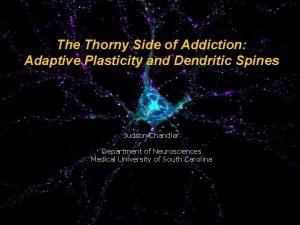Plasticity and Sensitive Periods in SelfOrganising Maps Fiona

- Slides: 1

Plasticity and Sensitive Periods in Self-Organising Maps Fiona M. Richardson and Michael S. C. Thomas f. richardson@psychology. bbk. ac. uk, m. thomas@psychology. bbk. ac. uk Developmental Neurocognition Lab, Birkbeck College, University of London Plasticity and the Brain • Within the brain there are systems that exhibit different plastic qualities: -The somatosensory cortex adapts quickly and retains its plasticity into adulthood (Braun et al. 2001). - In the language system, the ability of adults to learn phonological distinctions outside their language appears reduced in comparison to children (Mc. Candliss et al. 2002). How is plasticity lost or retained with age in self-organising systems? SOFMs: An Approach • Self-organising feature maps (SOFMs) are an unsupervised learning system, in which the similarity of exemplars is represented topographically. • Changes in plasticity in SOFMs are characterised by changes in learning rate and neighbourhood distance over training. • Typically, these values decrease over training, as the map organises and then fine tunes the representations. In our simulations we explored the ability of SOFMs to modify their category representations in two systems with contrasting plasticity. 154 dimensional feature space consisting of 9 categories, with 15 -30 exemplars per category. Parameter changes over time Comparing Reducing and Fixed Plasticity Maps (i) Development Reducing A comparison of active units for reducing and fixed maps • Fixed plasticity maps develop their representations quicker, but show little subsequent change or expansion. • The granularity of these representations is different for the two systems. (ii) Effective plasticity across training Fixed 5 epochs 50 epochs 100 epochs 250 epochs 550 epochs 850 epochs 1000 epochs Reducing: end state • Probed by introducing a new category at a later point in training. • For reducing maps adding a new category in the early stages of learning resulted in better overall representations. • Interference: new categories positioned themselves nearest the most similar existing category, causing disruption to existing representations. (iii) Thresholds - How do thresholds impact upon plasticity and category learning? Deterioration of category learning with decreasing plasticity A comparison of category activity for reducing and fixed maps Key: Humans = high similarity Fixed: end state Vehicles = lower similarity Oddments = low similarity 50 epochs 250 epochs 400 epochs 850 epochs (graphs showing the size of the added category upon completion of training) (point in training new category added at) Suggested threshold function • Constant thresholds seem to act as an impediment to learning. Reducing: end state no threshold Fixed: end state threshold 1 threshold 2 threshold 3 no threshold 1 threshold 2 threshold 3 • Fixed plasticity maps seem more resistant to the adverse effects of thresholds. (iv) Atypical categorisation and developmental disorders -Perhaps poor maps produce impaired categorisation? • For a poor map to result in impaired categorisation behaviour (Gustafsson, 1997): -Downstream output must be topographically organised for poor input topology to matter (Oliver et al. 2000). - Must have initial full connectivity between input and output. - Connectivity must be pruned back during the learning process, and pruning must produce receptive fields. Categorisation in normal and atypical systems Input, output and topology References: • Braun, C. , Heinze, U. , Schweizer, R. , Weich, K. , Birbaumer, N. , & Topka, H. (2001). Dynamic organization of the somatosensory cortex induced by motor activity. Brain, 124 2259 -2267. • Gustafsson, L. (1997). Inadequate cortical feature maps: A neural circuit theory of autism. Biological Psychiatry, 42, 1138 -1147. • Oliver, A. , Johnson, M. H. , Karmiloff-Smith, A. , & Pennington, B. (2000). Deviations in the emergence of representations: A neuroconstructivist framework for analysing developmental disorders. Developmental Science, 3, 1 -23. This research was funded by UK MRC Career Establishment Grant G 0300188 to Michael Thomas

